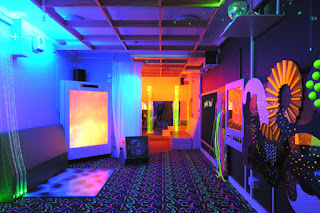The Benefits of a Sensory Room for Kids on the Autism Spectrum
The purpose of a sensory room is to waken your child's senses. Items in the room can include lights
is to waken your child's senses. Items in the room can include lights , sensory soft play objects
, sensory soft play objects , colors, sounds, and aromas
, colors, sounds, and aromas - all within a safe environment that allows him or her to explore and interact without risk.
- all within a safe environment that allows him or her to explore and interact without risk.
The room also helps the child to calm down when needed - and can help those who have learning difficulties or sensory impairments learn to interact with the world around them, but in a safe environment. The child gets an unrestrained space where he can explore at his own leisure.
It's most effective to create a schedule of when your child will be provided free time in this room. It's probably NOT best to give her free access to it. It's best to use the room at transition times to provide a smooth transition, or as a reward for meeting the expectations of parents and teachers.
When creating your child's sensory room, be as creative as you can. There are many things you can purchase, but you can also make many things yourself. What you use should in part be determined by what your child enjoys or is seeking.
Some ideas are:
- A mini trampoline
can provide physical exercise and sensory input.
- Create a touch board, and attach a variety of materials from sand paper to carpet.
- Fill a tub with sand, navy beans, or other similar item that they can play in.
- Find different scents of potpourri
that they can use for deep breathing.
- Hang a swing
from your ceiling (if it is reinforced).
- Have music playing that your child enjoys - this can be calming music
or vigorous music.
- String blinking Christmas lights
around the room.
- Use a hammock for the child to lie in and receive deep pressure.
- Use a variety of lotions
for both scent and touch.
- Use a vibrating massage-machine
for deep touch.
- Use play dough
for touch activities.
There are many benefits of a sensory room, for example:
Enhanced Learning through Play: Sensory stimulation can engage different areas of the brain, helping your child to absorb and retain more information through the five senses.
Improve Balance, Movement and Spatial Orientation: A sensory room can help develop your child's visual processing abilities and his or her fine and gross motor skills.
Sensory Stimulation: Encouraging your child to engage and explore the environment will have positive effects on her ability to react and interact with the larger world around her.
Tackle Problems With Behavior: Sensory rooms can be highly absorbing, providing a moment of comfort and calm for the "distressed" youngster, and helping the "inactive" child to feel better engaged. This improves focus and prevents him from getting the urge to ‘act out’ his frustrations or anxiety.
==> How to Teach Social Skills and Emotion Management



